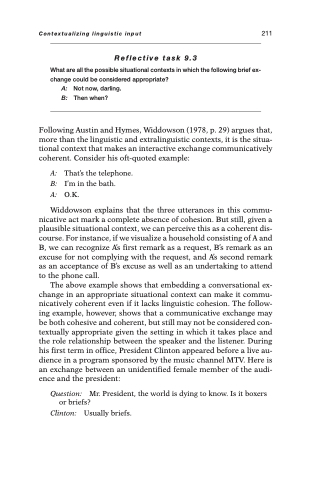Page 223 - Beyond Methods
P. 223
Contextualizing linguistic input 211
Reflective task 9.3
What are all the possible situational contexts in which the following brief ex- change could be considered appropriate?
A: Not now, darling.
B: Then when?
Following Austin and Hymes, Widdowson (1978, p. 29) argues that, more than the linguistic and extralinguistic contexts, it is the situa- tional context that makes an interactive exchange communicatively coherent. Consider his oft-quoted example:
A: That’s the telephone.
B: I’m in the bath.
A: O.K.
Widdowson explains that the three utterances in this commu- nicative act mark a complete absence of cohesion. But still, given a plausible situational context, we can perceive this as a coherent dis- course. For instance, if we visualize a household consisting of A and B, we can recognize A’s first remark as a request, B’s remark as an excuse for not complying with the request, and A’s second remark as an acceptance of B’s excuse as well as an undertaking to attend to the phone call.
The above example shows that embedding a conversational ex- change in an appropriate situational context can make it commu- nicatively coherent even if it lacks linguistic cohesion. The follow- ing example, however, shows that a communicative exchange may be both cohesive and coherent, but still may not be considered con- textually appropriate given the setting in which it takes place and the role relationship between the speaker and the listener. During his first term in office, President Clinton appeared before a live au- dience in a program sponsored by the music channel MTV. Here is an exchange between an unidentified female member of the audi- ence and the president:
Question: Mr. President, the world is dying to know. Is it boxers or briefs?
Clinton: Usually briefs.


